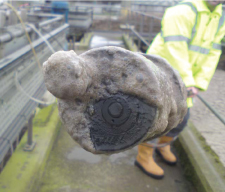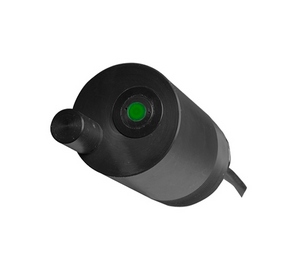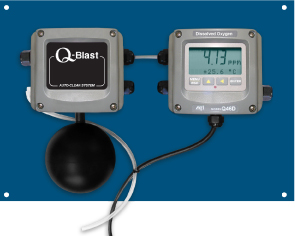- Home
- Products
- Water Measurements
- Analytical Technology Inc.
- Dissolved Oxygen
- Q46D Dissolved Oxygen Monitor
Q46D Dissolved Oxygen Monitor
Dissolved Oxygen monitor utilizing optical sensor with optional auto-cleaner
- General Details
- Features
- Documents
Dissolved Oxygen water quality monitoring is critical for aeration system process control. Optimization of the biological process, whether it’s removal of organic material, nitrification, or nitrification/denitrification, depends on maintaining proper D.O. levels. Controlling air flow to within the optimal range eliminates excess aeration, which translates into significant energy savings.
ATI’s Model Q46D Dissolved Oxygen Monitor is designed to provide reliable oxygen measurement and help reduce operating costs. Two types of sensing technologies are available for use with the Q46D system: Membraned Electrochemical and Optical (fluorescence). Both sensors will provide reliable long-term performance with minimal maintenance. No hardware modifications are required to change from one sensor type to the other. The monitor can be configured for AC or DC power supplies, and a portable battery-powered unit is available to meet a variety of monitoring needs.
When process conditions require frequent sensor cleaning, our unique Q-Blast Auto-Cleaner can be used to keep the system operating nearly maintenance free. This time-proven system has been instrumental in providing years of worry free operation.
The Q-Blast Auto-Clean assembly is housed in a NEMA 4X enclosure suitable for indoor or outdoor use. The system includes an integral compressor and air-pulse control components, with a power supply for the entire air supply system incorporated into the design. A simple connection to the Q46D monitor provides the sequencing for the system and allows the operator to select cleaning frequencies as often as once every hour to as little as once every 999 hours. To ensure performance in extreme cold conditions, a thermostatically controlled heater is included in the assembly, allowing operation down to -40°C.
The optical DO sensor operates on a light-based principle called “fluorescence” which is a type of luminescence. Certain chemical compounds will absorb one type of light energy, and then emit a different type of light energy. This light emission is called luminescence.The active portion of the sensor has a metal-based compound embedded in a structural matrix. A light source inside the sensor illuminates this compound which absorbs light at a specific wavelength. The compound then emits light at a different wavelength which is picked up by a photo detector within the sensor. As oxygen diffuses into the active sensor material it interacts with the light absorbing compound and interferes with the emission reaction. This interaction, called quenching, causes the light absorbing material to release energy in a form other than light. The degree of quenching is proportional to the concentration of dissolved oxygen. The quenching reaction is reversible, which allows this sensor to measure increasing and decreasing concentrations of oxygen.
 Optical sensors do not have internal electrolyte, so maintenance of this type of sensor is limited to changing the optical element. Over time, the element will lose the ability to absorb light due to a process called “bleaching”. With some sensors, this process is greatly accelerated when it is exposed to direct sunlight, and will cause irreversible damage to the sensor element.
Optical sensors do not have internal electrolyte, so maintenance of this type of sensor is limited to changing the optical element. Over time, the element will lose the ability to absorb light due to a process called “bleaching”. With some sensors, this process is greatly accelerated when it is exposed to direct sunlight, and will cause irreversible damage to the sensor element.Membraned type D.O. sensors have been used for D.O. monitoring and control for over 40 years and have proven to be consistently accurate and reliable. Properly designed, a membraned sensor will provide continuous service for a year or more without maintenance of any kind.
Galvanic oxygen sensors function in much the same way as a battery. The sensing elements consist of platinum cathode and lead anode, with a durable Teflon membrane isolating the sensor system from the liquid being measured.
 generates current between the platinum and lead electrodes which is proportional to oxygen concentration. An RTD temperature element measures water temperature and corrects the sensor signal for its effect. The result is a D.O. measurement that’s accurate over an operating range of -5-50°C.
generates current between the platinum and lead electrodes which is proportional to oxygen concentration. An RTD temperature element measures water temperature and corrects the sensor signal for its effect. The result is a D.O. measurement that’s accurate over an operating range of -5-50°C.Adaptability
Concentration version for direct display of chemical concentrations.
Extra Outputs
Expansion board to add a third 4-20 mA analog output or to add three additional non-isolated low power relays.
Flexibility
Wide range capability, with selectable ranges of 0-200.0 uS up to 0-2.000 S provide maximum application flexibility.
AC or DC Power Options
Power options include universal 100-240 VAC +/- 10%, or 12-24 VDC.
Flexibility
Programmable range options from 0-200 PPB up to 0-200 PPM provide maximum application flexibility.
AC or DC Power Options
Power options include universal 90-260 VAC or 12-24 VDC.
Analog Output Options
Two isolated 4-20 mA outputs are standard, with an option for a third output if required. Default setting provides analog outputs for conductivity and temperature.
PID Output
Standard PID control function assignable to one analog output.
Digital Communications
Available in either Profibus-DP, Modbus-RTU or Ethernet-IP.
Relay Assignable
Three SPDT relays are standard, with relay functions programmable for alarm, control, or trouble indication. Three additional low power relays available as an option.
Flexible Mounting
NEMA 4X (IP-66) enclosure is suitable for wall, pipe, or panel mounting.
Clear Display
Back-lit large LCD display provides clear visibility in any lighting conditions. A scrolling second line on the display provides additional information and programming prompts.





